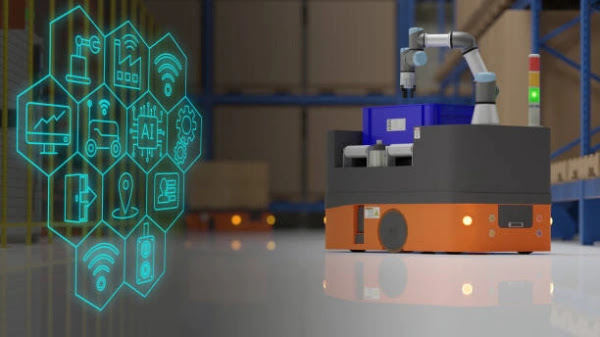Featured
- Get link
- X
- Other Apps
The Future of Industrial Robotics: Transforming Industries and Beyond
Industrial robotics has evolved from a niche concept to a transformative force across industries. As technology continues to advance, the future of industrial robotics holds exciting possibilities that promise to reshape manufacturing, drive innovation, and impact society as a whole. From enhanced automation capabilities to collaborative robots and new applications, let's explore the trends and potential scenarios that lie ahead for industrial robotics.
1. Advanced Automation and AI Integration:
Scenario: The integration of artificial intelligence (AI)
and machine learning (ML) with industrial robots will enable them to perform
tasks with higher complexity and adaptability.
Impact: Robots will become more capable of making real-time
decisions, learning from data, and optimizing their actions. This will lead to
increased productivity, as robots can handle tasks that require cognitive
abilities, such as problem-solving and decision-making.
2. Collaborative Robots (Cobots):
Collaborative robots, often referred to as cobots, are a
subset of industrial robots designed to work alongside humans in shared
workspaces. These robots are specifically engineered to collaborate with human
workers, providing assistance, enhancing productivity, and improving overall
efficiency. Unlike traditional industrial robots that often operate behind
safety barriers, cobots are designed to operate in close proximity to humans
without posing a significant risk to their safety. This innovative approach to
automation opens up new possibilities for industries across various sectors.
Scenario: Collaborative robots will become more prevalent,
working alongside humans in shared workspaces without the need for traditional
safety barriers.
Impact: Cobots will enhance efficiency by allowing humans and robots to collaborate on tasks that leverage their respective strengths.
This will be particularly valuable in tasks that require human dexterity and
creativity, paired with robot precision and strength.
3. Enhanced Safety and Human-Robot Interaction:
Scenario: Robots will be equipped with advanced sensors,
vision systems, and AI algorithms to ensure safe interaction with humans and
dynamic environments.
Impact: The risk of accidents will decrease, making it safer
for humans to work in close proximity to robots. This will facilitate the
adoption of robots in industries with complex and unpredictable work
environments.
4. Customization and Flexible Manufacturing:
Scenario: Robots will be capable of rapid reprogramming and
reconfiguration, enabling manufacturers to switch production lines quickly to
accommodate changing demands.
Impact: Manufacturers will be more agile and responsive to
market trends, reducing lead times for product development and customization.
This will drive greater customer satisfaction and competitiveness.
5. Human-Robot Collaboration in Complex Tasks:
Scenario: Robots will collaborate with humans in performing
complex tasks that require a combination of skills and expertise.
Impact: Industries like healthcare, aerospace, and
scientific research will benefit from the combined capabilities of humans and
robots in tasks that are beyond the capacity of either alone.
6. Application Diversification:
Scenario: Robots will find applications in new sectors and
industries beyond traditional manufacturing, such as agriculture, construction,
and hospitality.
Impact: These new applications will open up additional
revenue streams and create new business models. For example, robots could aid
in crop harvesting, building construction, or hotel services.
7. IoT Integration and Connectivity:
Scenario: Industrial robots will be connected to the
Internet of Things (IoT) ecosystem, enabling data exchange and real-time
monitoring.
Impact: Manufacturers will gather valuable insights on robot
performance, maintenance needs, and process optimization. Predictive
maintenance will reduce downtime and increase operational efficiency.
8. Augmented Reality (AR) and Virtual Reality (VR)
Integration:
Scenario: AR and VR technologies will enhance robot
programming, maintenance, and training processes.
Impact: Technicians will be able to visualize and interact
with robots in virtual environments, simplifying tasks such as programming and
troubleshooting. This will reduce the skill barrier and facilitate the adoption
of robotic systems.
9. Ethical Considerations and Regulation:
Scenario: As robots become more integrated into society,
ethical considerations and regulations will become increasingly important.
Impact: Discussions on topics like robot rights, safety
standards, and ethical AI will shape the future of robotics. Regulatory
frameworks will evolve to ensure the responsible development and use of robotic
technologies.
10. Socioeconomic Impact:
Scenario: The widespread adoption of robots may lead to job
displacement in certain industries, sparking discussions about the future of
work.
Impact: Societies will need to address challenges related to
reskilling and upskilling the workforce, as well as creating policies that
ensure a balance between automation and job preservation.
11. Quantum Leap in Robotic Materials and Components:
Scenario: Advances in materials science and miniaturization
will result in lighter, more durable, and energy-efficient robotic components.
Impact: Robots will become more agile, energy-efficient, and
capable of performing tasks in diverse environments, including those previously
considered challenging or inaccessible.
12. Sustainability and Green Robotics:
Scenario: Robotics will play a key role in sustainable
manufacturing processes, waste reduction, and energy efficiency.
Impact: Robots will contribute to reduced environmental
impact by optimizing resource utilization, minimizing waste, and aiding in
clean energy production.
In conclusion, the future of industrial robotics is
characterized by rapid technological advancements that will reshape industries
and redefine the boundaries of automation. From advanced AI integration and
human-robot collaboration to new applications and ethical considerations, the
possibilities are vast. As society navigates the challenges and opportunities
presented by these advancements, one thing is certain: industrial robotics will
continue to be a driving force in innovation, efficiency, and progress.
- Get link
- X
- Other Apps


